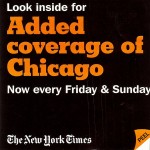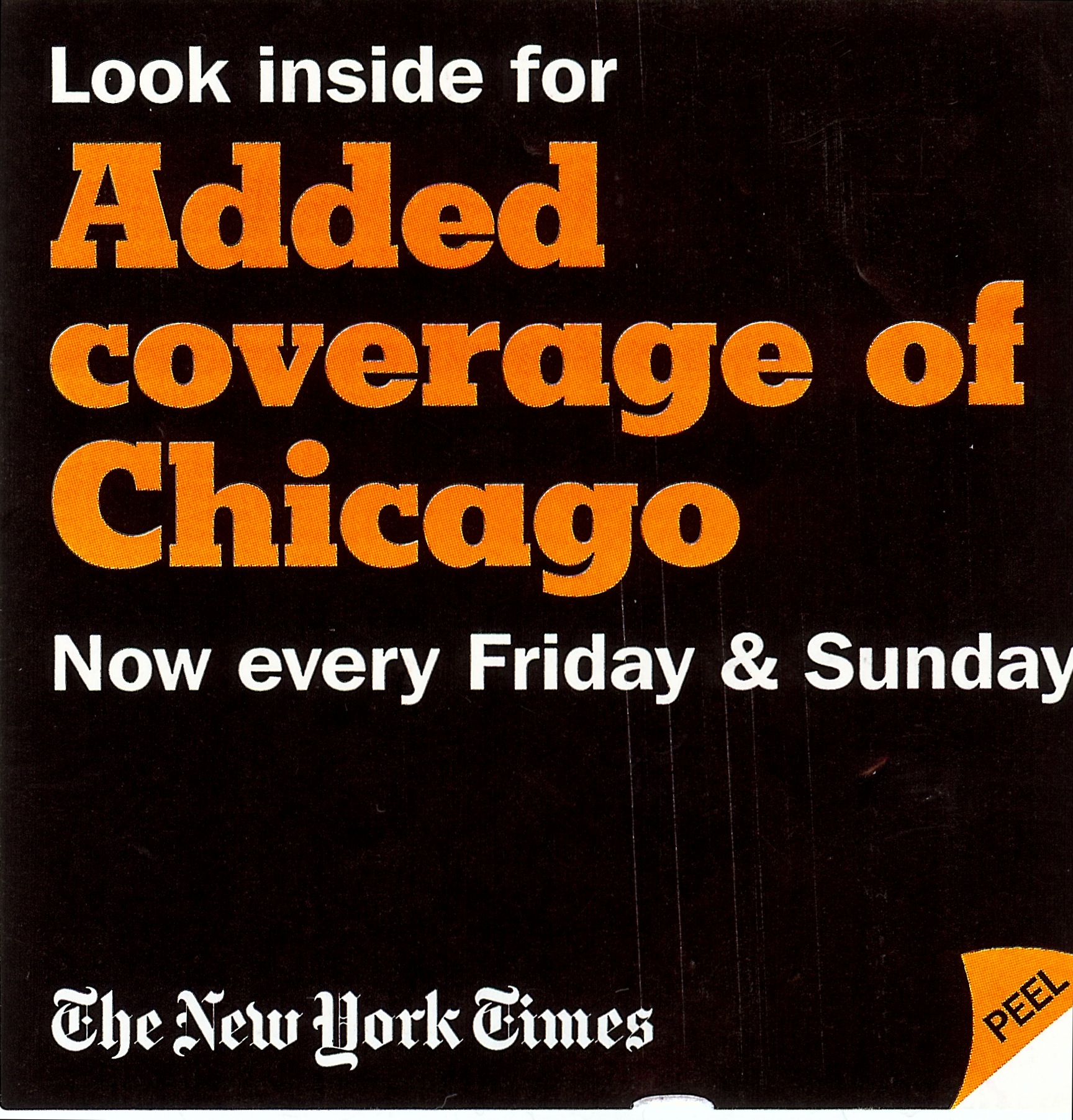The festival of links you can create these days when writing about new business models for the news industry is a wonder to behold. As we have noted here before, it seems sometimes there are almost as many conferences on the topic as there are stories about paid content, most of them involving Rupert Murdoch and/or Google.
 One prominent example, of course, is beginning to play out right here in Chicago: The Chicago News Cooperative launched last week, publishing two-page reports in the Friday and Sunday editions of the New York Times. I of course am watching with much interest, given that, by my count, I worked at the Tribune with around three-quarters of the 20 people named on the staff page today.
One prominent example, of course, is beginning to play out right here in Chicago: The Chicago News Cooperative launched last week, publishing two-page reports in the Friday and Sunday editions of the New York Times. I of course am watching with much interest, given that, by my count, I worked at the Tribune with around three-quarters of the 20 people named on the staff page today.
I suspect the Tribune and Sun-Times are watching with interest, too, given that the Tribune chose Sunday to publish another [not “the second” as originally reported–ORY] in a series of spadeas about its priorities (Capturing the Chicago Experience – click to download PDF, 3.44 mB). Its letter to readers from editor Gerry Kern ends, “We are Chicago’s newspaper. We tell your stories.”
(By my lights, the most remarkable thing about the Chicago News Cooperative example is that the NYT’s own journalists actually wrote about the launch. I guess that’s another example of how the world is changing; in the Olden Days, writing about anything your employer had done to try to improve its business prospects had a good chance to get you hooted out of any newsroom in America.)
But let’s not spend any more time here on background. If you want more, read Alan Mutter’s piece at “Reflections of a Newsosaur” from earlier this month. Instead, let’s see what Chicago readers found in their driveways and newsstands Friday and Sunday morning, and not just in the NYT (using the acronym consistently today, to avoid confusion).
After all, CNC editor Jim O’Shea and his colleagues say they’re not out to supplant the existing newspapers; they are out to protect and sustain a kind of reporting they perceive as threatened, the public-service journalism “that we feel is crucial for a democracy . . . and provide accountability for the institutions and public officials in the city, county and state.” (Quote is from a WTTW interview with O’Shea, video after the jump.)
Friday
 Friday’s lede piece in the NYT from the Cooperative delivered on that premise/promise, with the revelation that the much-reviled operators of the much-complained-about privatization of the City of Chicago’s parking-meter business will make a 70 per cent margin this year on their $1.1 million-plus of weekly revenue. Jim Warren’s column on a food pantry in Ravenswood also stayed on mission, evoking the divide between rich and poor, have and have-not, that so characterizes much of the city. Since the NYT was dealing with that quintessential Chicago story, Oprah, elsewhere in the paper, the Chicago pages also had room for a piece on the Modern Wing of the Art Institute and for a couple of briefs.
Friday’s lede piece in the NYT from the Cooperative delivered on that premise/promise, with the revelation that the much-reviled operators of the much-complained-about privatization of the City of Chicago’s parking-meter business will make a 70 per cent margin this year on their $1.1 million-plus of weekly revenue. Jim Warren’s column on a food pantry in Ravenswood also stayed on mission, evoking the divide between rich and poor, have and have-not, that so characterizes much of the city. Since the NYT was dealing with that quintessential Chicago story, Oprah, elsewhere in the paper, the Chicago pages also had room for a piece on the Modern Wing of the Art Institute and for a couple of briefs.
The Friday Tribune, though, held its own on the public-service front. Without failing to cover Oprah, the two slugs on Page One both fell under editor Gerry Kern’s “watchdog” rubric:
- News that the state was looking to crack down on high school districts that “disappeared” thousands of their juniors in order to improve their schools’ test scores, a fact that the Tribune pulled out of state data in a wonderful story back on Nov. 1; and
- Another installment in the newspaper’s “Compromised Care” series about problems in protecting nursing-home residents from criminals and the mentally ill.
Whereas Warren’s column exhorted readers to consider volunteering at a food pantry to help the less fortunate, in the Tribune Mary Schmich powerfully wrote about someone who actually did just that. Meanwhile, on the culture front, while Jessica Reaves’s piece on the Modern Wing in the NYT was dandy in whether it can attract new audiences and new donors to the Art Institute, Blair Kamin got my attention on page 10 not only by writing about potential changes for Grant Park and Meigs Field, but also by adding, “And – hold your breath – they might even turn out for the better.”
And still, you needed the Sun-Times’s Fran Spielman for the news that DePaul had gotten unanimous approval from the city Plan Commission for its 10-year master plan, or to learn that this year will be the last for the Adler Planetarium’s “Star of Wonder,” which has been running in some form for more than 70 years. On this day, all three papers were watching the city, and rewarding city-watchers who were watching them.
Sunday
The Sunday Sun-Times has had its work cut out for it against the Tribune for years, starved of both ROP and insert advertising dollars and therefore without the newshole to compete on anything like a level playing field. That forces an editor to make choices, and Sunday’s Page One choices (more Oprah, movie previews, Susan Boyle, the food section, movie piracy) left even the uneven playing field wide open for the Trib and the Cooperative. The coverage of Michael Scott’s funeral, including a Mark Brown column, was the edition’s news anchor, and Lynn Sweet briskly advanced the Thomson Correctional Center story by getting hold of a White House study about potential job creation there.
There is way more sports than anything else in the Sunday S-T, of course. Was that one reason the News Cooperative devoted some of its space to analyzing the Lovie Smith era with the Bears? It does live up to the NYT’s subscription campaign, and ex-Tribune sports editor Dan McGrath makes a case for its appearance in the body of the text: “No other team, no local institution, comes close to matching the death grip the Bears have on the city’s sporting psyche.” Judging by Jay Cutler’s 18 interceptions so far this season, it probably would be a good thing for the CNC to hold this particular institution accountable too.
The main CNC article surfaces the argument that “gang chaos” attributable in part to the police’s current gang-fighting tactics is one reason that about 60 per cent of this year’s homicides in the city are still gang-related. Solidly reported, balanced in sourcing, and ultimately drawing no conclusions, it ends with bleak anecdotes and quotes that support its headline, “Police Struggle to Navigate New Gang Landscape.”
Next door to the gangs, I enjoyed Jim Warren’s column about the ex-political-reporter-who-no-longer-is-next-door, David Axelrod, just as I had enjoyed talking with Axelrod at a recent Tribune reunion. But between that and Lovie Smith, I wondered: If so inclined, would this be enough of Chicago to allow someone to completely drop the Sunday Tribune or Sunday Sun-Times? Alternatively, would it be enough to keep me from dropping my own $700 Times subscription if I were on the fence? (It can easily be argued that those wouldn’t be the NYT’s business goals. Maybe the business side sees meaningful ROP advertising attached – or, more likely, they see this as a way to make it even easier for them to skim the cream off the Tribune’s high-end insert advertising in upscale ZIP codes. But the questions a reader might ask are not going to involve wondering about the fate of the Goodman Theater inserts.)
This then winds up not being a question about the Chicago News Cooperative, or the need for it, or its role. I certainly hope that when the NCN’s full Web site, ChicagoScoop, arrives next year, that its journalism, its business model, and its raison d’être all hold up. I’m sure I’ll be paying my two bucks a week, or whatever the CNC wants to charge me, just as I already pay to support other worthy online endeavors, like David Warsh’s Economic Principals. And I am glad that the NYT is a paying customer, helping the Cooperative provide good jobs for good journalists, and over time lots of good journalism on behalf of democracy.
As you might guess, if I started linking to all the things in the Sunday Trib that made it worth $1.99 to a would-be informed citizen, we’d be here all night. But not (disclosure) because I’ve been doing some digital consulting there; it’s because I think Kern’s letter to readers does get it right. Though the current Chicago Tribune inarguably is not “the same paper” that O’Shea or I worked at, it seems to me that on most days it is (quoting Kern on Sunday) “a mirror reflecting the drama, vitality, and hope of life in Chicago.”
A few things about mirrors:
- They reflect things we don’t want to see, including things we don’t want to see about ourselves.
- They nevertheless distort the picture, starting with the fact that the image is flopped.
- The angle of incidence equals the angle of reflection. That is, wherever you point your mirror and wherever I point mine, we each will see something unique based on where each of us is standing.
My spins through these six editions makes me want more, not less; makes me want it to get it on my iPhone way more easily than I do today; makes me want a better e-reader; makes me need a better way to create my RSS feeds; makes me want my journalists of choice to create convenience not just for me, but for everyone their work should benefit.
The back story shouldn’t matter. Just the stories themselves.
| Last edited by Owen Youngman on December 7, 2009 at 4:36 pm |


As always Owen you bring a thorough and thoughtful perspective.
How, exactly, is this a cooperative? Will it be a consumer co-op owned by its customers on a one owner-one vote basis, on the same legal model as a food co-op or a credit union? Will it be a producer co-op, owned by its writers and editors in the way Land o’ Lakes is owned by the dairy farmers and dairy owners who produce its butter and cheese? Or will it be a co-op in name only, owned by a 501(c)3 that signs up subscribers and calls them members the way public broadcasting calls its contributors “members”? Or what?
What it comes down to is, who owns this? At this point, might it be that WTTW owns it? Will that change?